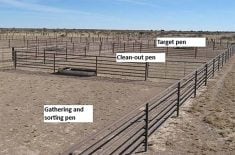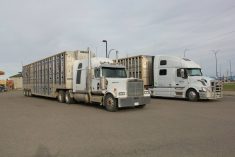The number and severity of livestock cruelty cases are much higher this winter compared to last year, according to the Saskatchewan SPCA.
Cases involving cattle increased 89 percent to 34 this winter (December 2012 to February 2013) from 18 last winter, while cases involving horses increased 76 percent to 58 from 33.
Kaley Pugh, the Saskatchewan SPCA’s manager of animal protection services, said she isn’t sure why the number of cruelty cases is in-creasing.
“I think a lot of it is weather related. There could be feed quality issues in some areas,” she said.
Read Also

Charges laid after cattle theft
Saskatchewan RCMP lay two charges against a man after six cattle went missing.
“It’s not just the amount of snow or not just the temperature but the fluctuations that have made conditions extra hard out there.”
The severity of livestock cases is of particular concern. The Saskatchewan SPCA has seen 11 Priority 1 files involving cattle and horses this winter, up from two Priority 1 files last winter.
A Priority 1 case, which requires immediate action by the SPCA, involves dead or dying animals, animals without water, starving animals or other situations where the life of the animal is at immediate risk.
“The severity is what’s really alarming. We don’t normally have as many cases of what we call Priority 1 files, where there’s already dead animals or animals in severe distress already when we get the call,” said Pugh.
“There’s about 10 times as many this year as there were last year and even more than the year before, which was also a bad winter.… These are legitimate cases of not enough groceries, and that’s what’s disturbing for us.”
Pugh questions the decline in cattle health in Saskatchewan, considering the favourable commodity climate in the beef industry.
“Sometimes when the value is low we see some more neglect issues, but you’d think with the values being pretty good that this is a little bit surprising,” she said.
Winter is far from over, and feeding challenges associated with heavy snowfalls and extended periods of cold could remain. The high cost of feed is also creating additional pressure for owners.
Changes in feed and management may be required to protect animals from distress.
The Animal Protection Act defines an animal in distress as one that is deprived of adequate food, water, care or shelter, is injured, sick, in pain or suffering or is abused or neglected.
Pugh said better reporting might explain the increased numbers. Complaints have come from across the province, she added.
“We really want to encourage people to call us before it’s an emergency, if they’re concerned about animals in their area to call us as soon as they become concerned and not wait until there’s dead animals to call us,” she said. “If we get notified of concerns earlier, we can intervene sooner and hopefully prevent some of these situations from getting as serious as they do get sometimes.”
The public can report animals that may be suffering because of a lack of food, shelter, water or care by calling the Saskatchewan SPCA at 877-382-7722. All calls are confidential.
- So far in the winter of 2012-13, eight Priority 1 cases were launched, seven involving cattle, one involving horses. In the winter of 2011-12, there were two Priority 1 cases, both involving cattle.
- There was about a 19 percent increase in the total number of cases initiated by the Saskatchewan SPCA for all types of livestock in the winter of 2012-13 compared to the previous winter.
- Between Dec. 1, 2012 and Feb. 22, 2013 the SPCA investigated 154 cases, 58 involving horses, 34 involving cattle. From Dec. 1, 2011 to Feb. 28, 2012, it investigated 129 cases, 33 involving horses, 18 involving cattle.


















